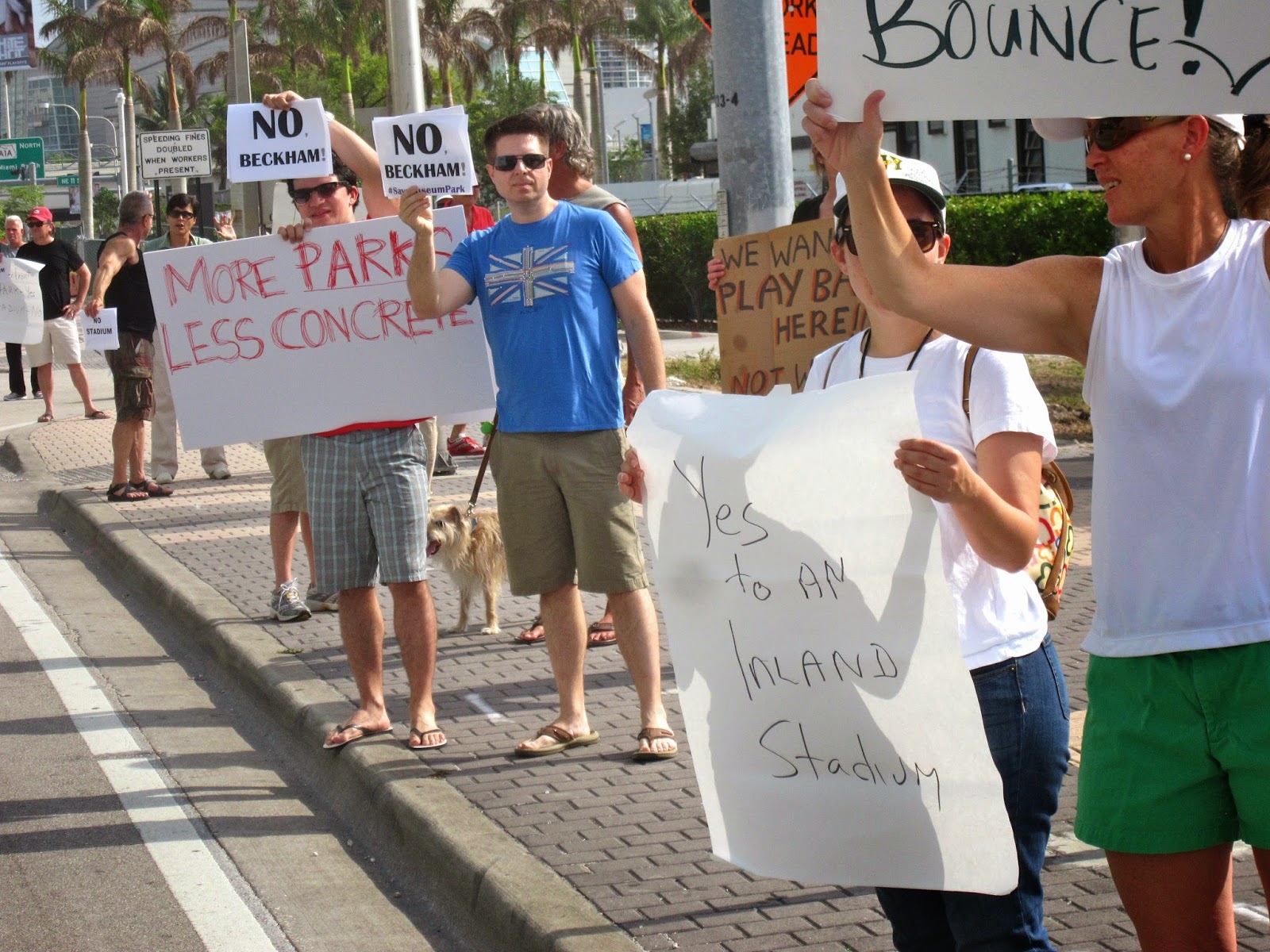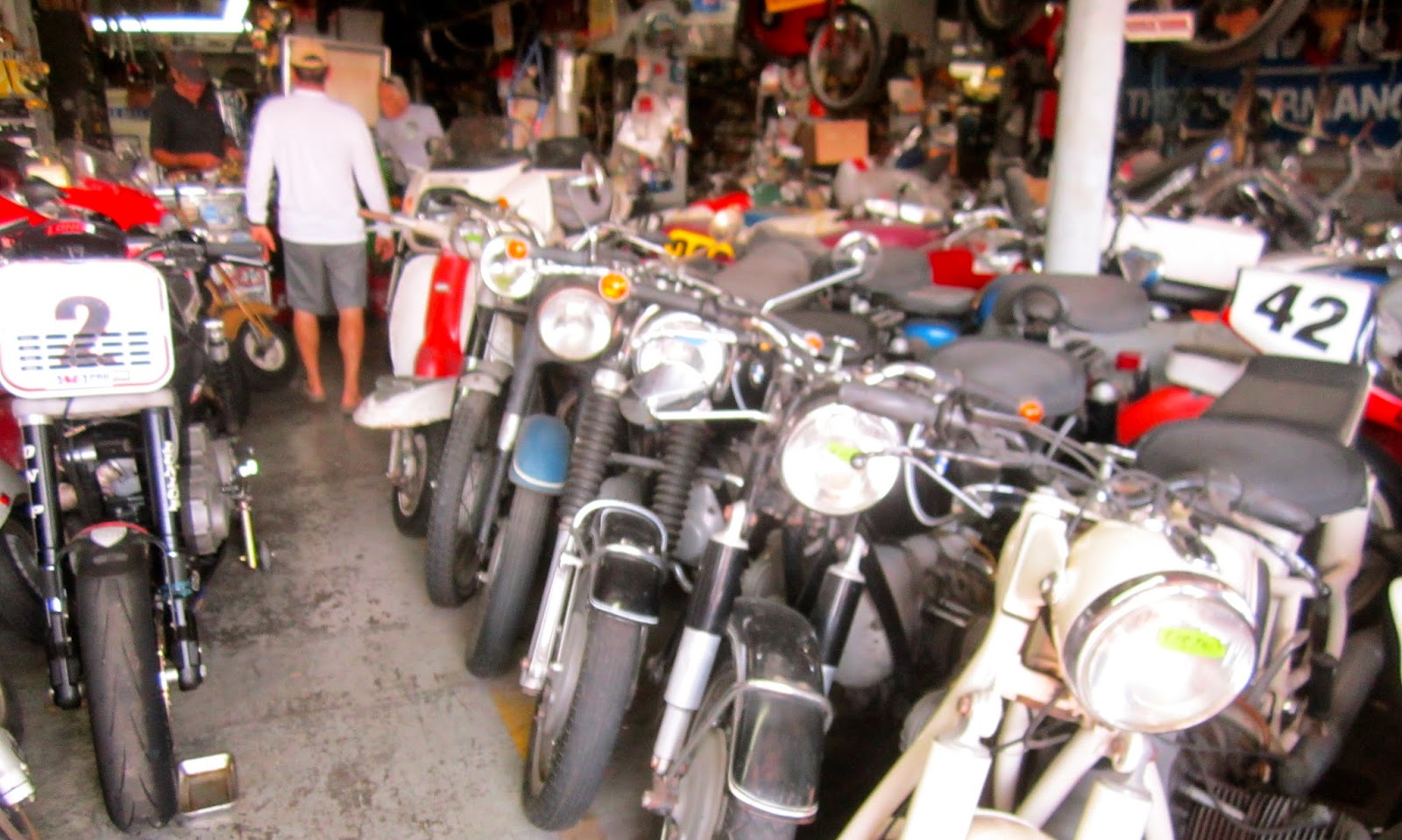The park is just north of the Arena, on Biscayne Bay.
A spacious basin separates Museum Park from the basketball venue. We just spent $15 million to
rebuild its seawalls.
Looking south to the Arena and Downtown Miami
Here, the Freedom Tower seems to be dancing with park's new Cundo Burmudez statue.
 North of the basin are hills, trees, and acres of luscious, green open space. Just beyond is the new Perez Art Museam and the Frost Science Museum.
North of the basin are hills, trees, and acres of luscious, green open space. Just beyond is the new Perez Art Museam and the Frost Science Museum.
If this sounds too good to be true, you may be right. Local officials now want to plop a huge soccer stadium in the middle of this beautiful public space .

Our City of Miami and county mayors support Beckham's plan. No word from our commissions yet.
It is such an awful idea. It will be a disaster for everyone who enjoys open space, public parks and sensible urban design.
We must stop David Beckham and his hair-brained proposal.
We began the effort today
with a demonstration on Biscayne Boulevard, just next to the park.

 Yes, that's Francesca holding her sign and flexing her muscles on the building beyond.
Yes, that's Francesca holding her sign and flexing her muscles on the building beyond.
We were just a few dozen people shouting by a road but if we can grow into a majority of voters to fight this, we can save Museam Park.
_______________
Last week, fellow demonstrator Greg Bush wrote this op-ed piece for the Miami Herald.
_______________
Last week, fellow demonstrator Greg Bush wrote this op-ed piece for the Miami Herald.
SOCCER STADIUM
Preserve public waterfront open space

BUSH
BY GREGORY BUSH
PUBLICBUSH@GMAIL.COM
Who wouldn’t want a waterfront site for their stadium or for a Cuban Exile History Museum?
John Henry of the Marlins surely did back in 2000 when he spent millions trying to secure space for a stadium in Bicentennial Park. Yet led, in part, by the Urban Environment League, multiple forces coalesced to stop his powerful and expensive lobbying team, stimulating a unique public design process that eventually saw two museums being placed in the park.
A real park was also supposed to be part of the plan — but that has yet to materialize after more than a dozen years of inattention. Then, after endless negotiations, public officials finally made a very bad deal to pay billions for the Marlins Stadium — though thankfully not on the waterfront. Can’t we do better this time and stop obsessing about taking even more waterfront space for a stadium or another museum at more unknown costs to the public? Sometimes it seems we are reliving an old story in a region whose memory is so notoriously weak.
Some considerations in this debate:
• Public open space has long been particularly vulnerable on Miami’s waterfront. Miami has among theleast amount of park space per capita of any major high-density city in the country. Politicians have promised to expand waterfront park space time and again in the past, but when have they delivered in recent decades? Parcel B? Bicentennial Park after 1976? What has happened to the funds to buy other waterfront land derived from a portion of the profits from Bayside — as prescribed in city and state legislation?
Impact fees are inadequately collected for new park space even though the downtown area desperately needs new parks as one hears from the recently created Downtown Neighborhood Association representing more than 27,000 new residents.
• Soccer will only play 25 games a year in a soccer facility, yet how would investors make money out such a stadium in the FEC slip? Clearly big profits are central to their plans.
• What happened to the idea of smaller ships in the slip or tall ships that could bring people to the waterfront? Do we live on a real waterfront for residents and tourists or a stage set/theme park in today’s news? Other great cities around the world cherish and expand their waterfront parks; Miami generally has event spaces with little regard to human-scale relationships to the natural world.
• A critical problem in assessing our waterfront involves the jurisdictional complexity of these waterfront spaces — leading to public cynicism. The slip is city property; Parcel B is county property subject to city zoning regulations; the Biscayne Bay Aquatic Preserve and the Shoreline Review Committee also have jurisdiction — and more. Public understanding of these complex issues remains minimal. The Florida Inland Navigation District — public tax money — provided millions to upgrade the seawall of the slip and Parcel B in the last few years. Was that money totally wasted?
• From an urban-design perspective, this site would block even more views of the waterfront for local residents and the public unless one walks along the nonexistent baywalk — originally promised to residents back in 2001. That’s aside from the height and noise of a stadium.
• Above all else, the question of density including traffic congestion should remain paramount in the discussion. Even now projects in the downtown area and Biscayne Boulevard more generally are driving residents, commuters and others crazy — before new buildings come online. Traffic studies have, quite obviously, become even more of a fraudulent inside joke.
• Other sites for both the soccer stadium and the Cuban Exile History Museum have been inadequately examined with public input. Maybe the port site works, or doesn’t, but David Beckham and local politicians should certainly look at other sites.
• Above all, we should not be rushed by private interests in this media frenzy but demand an orderly public process in which a clear set of criteria to preserve public waterfront open space remains paramount. Public debates should include new ideas in a thoughtful urban design process. What a concept!
Gregory Bush is the director of the Institute for Public History at the University of Miami.
John Henry of the Marlins surely did back in 2000 when he spent millions trying to secure space for a stadium in Bicentennial Park. Yet led, in part, by the Urban Environment League, multiple forces coalesced to stop his powerful and expensive lobbying team, stimulating a unique public design process that eventually saw two museums being placed in the park.
A real park was also supposed to be part of the plan — but that has yet to materialize after more than a dozen years of inattention. Then, after endless negotiations, public officials finally made a very bad deal to pay billions for the Marlins Stadium — though thankfully not on the waterfront. Can’t we do better this time and stop obsessing about taking even more waterfront space for a stadium or another museum at more unknown costs to the public? Sometimes it seems we are reliving an old story in a region whose memory is so notoriously weak.
Some considerations in this debate:
• Public open space has long been particularly vulnerable on Miami’s waterfront. Miami has among theleast amount of park space per capita of any major high-density city in the country. Politicians have promised to expand waterfront park space time and again in the past, but when have they delivered in recent decades? Parcel B? Bicentennial Park after 1976? What has happened to the funds to buy other waterfront land derived from a portion of the profits from Bayside — as prescribed in city and state legislation?
Impact fees are inadequately collected for new park space even though the downtown area desperately needs new parks as one hears from the recently created Downtown Neighborhood Association representing more than 27,000 new residents.
• Soccer will only play 25 games a year in a soccer facility, yet how would investors make money out such a stadium in the FEC slip? Clearly big profits are central to their plans.
• What happened to the idea of smaller ships in the slip or tall ships that could bring people to the waterfront? Do we live on a real waterfront for residents and tourists or a stage set/theme park in today’s news? Other great cities around the world cherish and expand their waterfront parks; Miami generally has event spaces with little regard to human-scale relationships to the natural world.
• A critical problem in assessing our waterfront involves the jurisdictional complexity of these waterfront spaces — leading to public cynicism. The slip is city property; Parcel B is county property subject to city zoning regulations; the Biscayne Bay Aquatic Preserve and the Shoreline Review Committee also have jurisdiction — and more. Public understanding of these complex issues remains minimal. The Florida Inland Navigation District — public tax money — provided millions to upgrade the seawall of the slip and Parcel B in the last few years. Was that money totally wasted?
• From an urban-design perspective, this site would block even more views of the waterfront for local residents and the public unless one walks along the nonexistent baywalk — originally promised to residents back in 2001. That’s aside from the height and noise of a stadium.
• Above all else, the question of density including traffic congestion should remain paramount in the discussion. Even now projects in the downtown area and Biscayne Boulevard more generally are driving residents, commuters and others crazy — before new buildings come online. Traffic studies have, quite obviously, become even more of a fraudulent inside joke.
• Other sites for both the soccer stadium and the Cuban Exile History Museum have been inadequately examined with public input. Maybe the port site works, or doesn’t, but David Beckham and local politicians should certainly look at other sites.
• Above all, we should not be rushed by private interests in this media frenzy but demand an orderly public process in which a clear set of criteria to preserve public waterfront open space remains paramount. Public debates should include new ideas in a thoughtful urban design process. What a concept!
Gregory Bush is the director of the Institute for Public History at the University of Miami.































